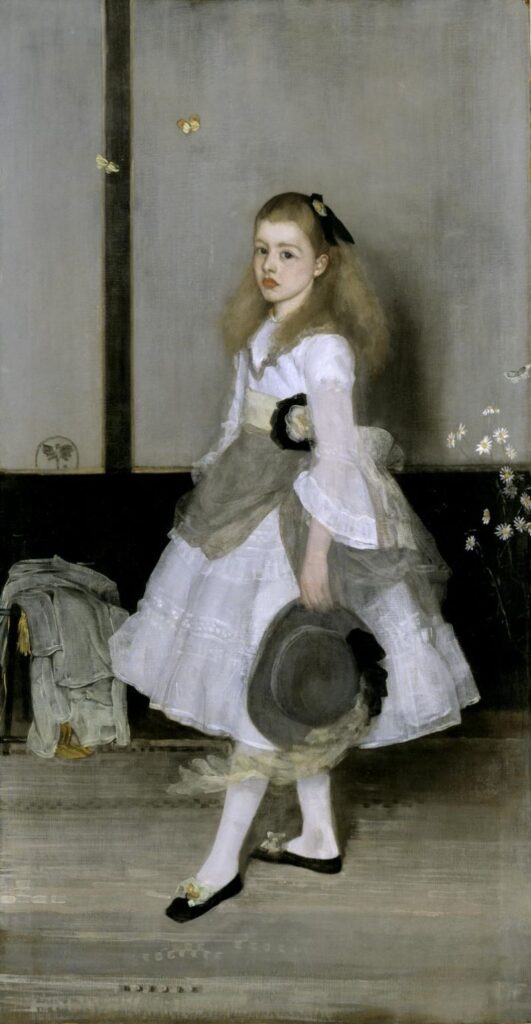Harmony in Grey and Green: Miss Cicely Alexander
This stunning painting came into being thanks to the Arrangement in Grey and Black: Portrait of the Painter’s Mother, which Whistler had painted in 1871, the year before he created this one. Collector William Cleverly Alexander was so impressed by the Mother that he commissioned Whistler to paint comparable portraits of all of his daughters—five of them, at the time. It was a substantial commission, but one of which Whistler could not take full advantage. Plagued by his lifelong difficulty in finishing paintings to his full satisfaction, he only succeeded in capturing young Cicely.
Sitting for Whistler was an ordeal for the girl. Whistler demanded she hold her pose for hours at a time, for as many as seventy grueling sessions. He heightened the torment with his many promises of breaking for lunch, or of ending the day early—promises that he invariably reneged upon. “I used to get very tired and cross,” Cecily remembered, “and often finished the day in tears.” Her sullen frustration can be seen in the finished work. So can an incredibly beautiful and delicate interplay of color. This painting is arguably the most harmonious of all of his color-harmonies. And of all his works, this is the one that demonstrates most clearly Whistler’s indebtedness to the great Diego Velàzquez. (Whistler did acknowledge that debt, but treated it lightly: “Why drag in Velàzquez?” he once joked to a woman who commented upon their mutual greatness.
This painting led to an early salvo in Whistler’s lifelong barrage against the critics, when England’s second-most critic, Tom Taylor, pointed out to Whistler that the dark upright line in the paneling behind the girl was a flaw, and that the painting would have been better without it. “Of course,” he added, “it’s a matter of taste.” To which Whistler replied “I thought that perhaps for once, you were going to get away without having said anything foolish; but remember, so that you may not make the same mistake again, it is not a matter of taste at all, it is a matter of knowledge. Good-bye.” This battle between artist and critic was one the two would take up again in 1878 when both testified in Whistler v. Ruskin.
Another critic—the writer George Moore—had no problems whatsoever with the Harmony in Grey and Green. Indeed, he considered the painting as a masterpiece on a par with the Mother. When in 1891 Whistler exhibited those two paintings side by side in London, Moore exhorted the British public to mount a campaign to obtain either one of them for the National Gallery. The public ignored him. Later that year, when the French government bought the Mother for the Luxembourg (and eventually for the Louvre), Moore tried again: the Harmony in Grey and Green was still available, and the British public should snap it up. Again, the public ignored him. The painting therefore remained with William Cleverly Alexander until he died in 1916, and then went to his daughter Cicely, who held it until she died in 1932. Only then did it come into the possession of the British public, hanging first in the Tate and then in the National Gallery, until it returned to the Tate, where it hangs today. Unlike the magnificent Crepuscule in Flesh Colour and Green, also owned by the Tate but not exhibited, it actually does hang there, on permanent public view.
Thank goodness for that. The work is a marvel: one of those paintings that gets better with every viewing.

